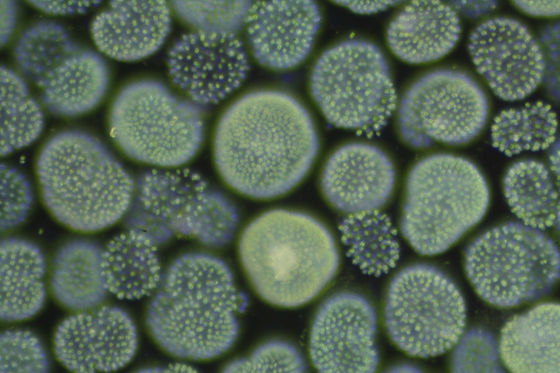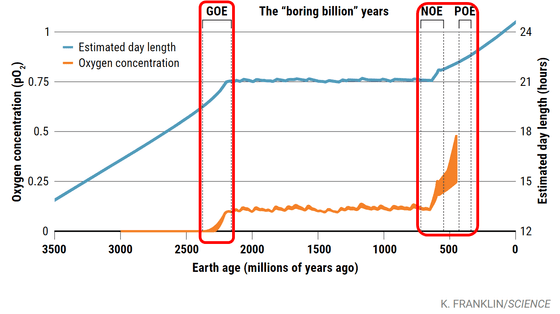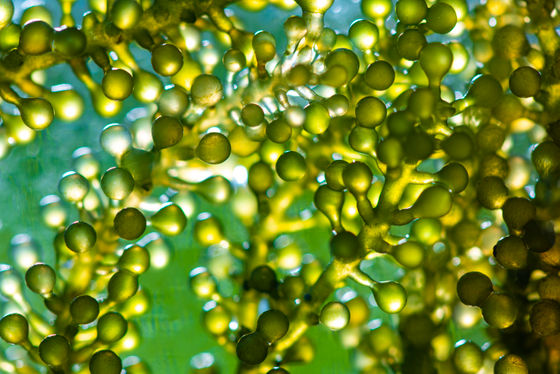As a result of research that the earth has abundant oxygen 'thanks to the slow rotation of the earth', the ancient earth had only 6 hours a day.

Not only animals including humans, but also plants and microorganisms that produce oxygen by photosynthesis live by breathing in and exhaling carbon dioxide. In this way, the research result that 'the rotation of the earth has slowed down' has been published in the scientific journal Nature that the oxygen that supports life living on the earth has become abundant as it is now.
Possible link between Earth's rotation rate and oxygenation | Nature Geoscience
'Totally new' idea suggests longer days on early Earth set stage for complex life | Science | AAAS
https://www.sciencemag.org/news/2021/08/totally-new-idea-suggests-longer-days-early-earth-set-stage-complex-life
Slowdown of Earth's spin caused an oxygen surge | Live Science
https://www.livescience.com/early-earth-rotation-increase-oxygen.html
It is said that the large amount of oxygen present in the Earth's atmosphere is due to a large oxidation event in which algae produced oxygen by photosynthesis about 2.4 billion years ago. However, since it was found by excavation of fossils that the first photosynthetic microorganisms were born about 3.5 billion years ago, 'It is about 1 billion years from the birth of early algae to the major oxidation event. The question, 'Why is there a time lag?' Has long plagued scientists.

by
Judith Kratt of the Max Planck Institute for Marine Microbiology, who was working on this issue, realized from an accidental discovery that 'the time of the major oxidation event and the rate of rotation of the earth changed significantly is almost the same.' rice field.
The following is a graph showing the relationship between the length of the day (blue line graph) and the amount of oxygen (orange). The day of the earth, which was only about 6 hours immediately after the birth of the earth, slowed down due to the gravitational pull of the moon and became about 21 hours about 2.4 billion years ago. And it was around this time that the first major oxidation event (GOE) took place. After that, about 500 million years ago, at the same time that the orbits of the earth and the moon were out of balance and the length of the day became 24 hours, the 'Neoproterozoic Oxidation Event (NOE)' and 'Paleozoic Oxidation' Event (POE) is occurring.

To confirm the relationship between oxygen and the Earth's rotation rate, Mr. Krat collected and experimented with cyanobacteria that live in Lake Huron, one of the largest freshwater lakes in the world. Lake Huron has shallow waters where cyanobacteria can photosynthesize, while water and sulfur gas with low oxygen are gushing out from the bottom of the lake, and it is said that the same anoxic state as the ancient earth's sea is maintained.
When Mr. Krat conducted an experiment to reproduce the change in sunshine duration by changing the length of light shining on the cyanobacteria of Lake Huron, it was confirmed that the longer the sunshine duration, the more active the photosynthesis. I did. In addition, Mr. Krat and Mr. Arjun Chennu, a theorist at the Leibniz Tropical Ocean Research Center, constructed and simulated a model of 'how the oxygen produced by cyanobacteria and the oxygen consumed change depending on the sunshine time'. As a result, the result was consistent with the amount of oxygen gas produced by photosynthesis by cyanobacteria in the laboratory.
Regarding the mechanism by which the amount of oxygen released into the atmosphere increases as the day becomes longer, the research team said, 'Oxygen produced by cyanobacteria

It is thought that various factors other than the mechanism discovered this time are involved in the amount of oxygen on the earth. For example, according to Timothy Lions, a biogeochemist at the University of California, Riverside, not only cyanobacteria that live on rocky microbial mats, but also cyanobacteria that float in the water played a major role in supplying oxygen. thing. Other studies have pointed out that the minerals that appeared on the surface of the earth due to volcanic activity combined with oxygen, offsetting the oxygen supply by early cyanobacteria.
As such, the research team wrote in a treatise, 'The dynamics between the Earth and the Moon may have had a significant impact on oxygen levels at key turning points in the evolution of living organisms. The effects have been proposed so far. It was working in parallel with the various mechanisms that came up. '
Related Posts:







